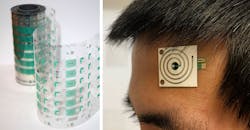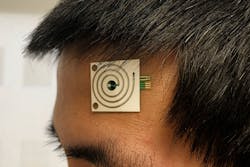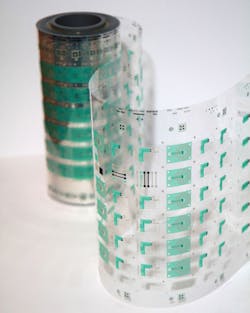A development team at the University of California, Berkeley is making a wearable skin sensor that can detect what’s in a person’s sweat. Such a sensor could monitor perspiration and bypass the need for invasive procedures such as blood draws, all the while providing real-time updates on health problems such as dehydration and fatigue.
The sensor is just part of a larger project that wants to determine what a person’s sweat can reveal about the health of a person. “For that we need sensors that are reliable, reproducible, and that we can fabricate to scale so we can put several sensors in different spots of the body and put them on many subjects,” says Ali Javey, a professor of electrical engineering and computer science at UC Berkeley.
The new sensors contain a spiraling microscopic tube, or microfluidic, that wicks sweat from the skin. It measures how fast sweat moves through the microfluidic so the sensor can determine how much a person is sweating. The microfluidics are also outfitted with chemical sensors that detect concentrations of electrolytes such as potassium and sodium, and metabolites such as glucose.
New wearable sensors developed by scientists at UC Berkeley can provide real-time measurements of sweat rate and electrolytes and metabolites in sweat. (Courtesy: Bizen Maskey, Sunchon National University)
Javey and his team worked with researchers at the VTT Technical Research Center of Finland to develop a way to quickly manufacture the sensor patches in a “roll-to-roll” processing technique similar to screen printing. Roll-to-roll manufacturing essentially prints the sensors onto a sheet of plastic
“Roll-to-roll processing enables high-volume production of disposable patches at low cost,” says VTT’s Jussi Hiltunen. “Academic groups gain significant benefit from roll-to-roll technology when the number of test devices is not limiting the research.”
Part of the research involved placing the wearable monitors on several human test subjects. The sensors were placed in different spots on the subjects, including the forehead, forearm, underarm, and upper back . The sensors then monitored the sweat rate, and the electrolytes and metabolites in sweat, from subjects who were exercising and others who were experiencing chemically induced perspiration.
The sensors can be rapidly manufactured using roll-to-roll manufacturing prints the sensors onto a sheet of plastic. (Courtesy: Antti Veijola, VTT)
Researchers discovered that local sweat rates could indicate the body’s overall liquid loss during exercise, so tracking sweat rate might be a way to give athletes a heads-up when they may be pushing themselves too hard.
“Traditionally what people have done is they would collect sweat from the body for a certain amount of time and then analyze it,” says Hnin Yin Nyein, a graduate student in materials science and engineering at UC Berkeley. “So you couldn’t really see dynamic changes very well with good resolution. With these wearable sensors, we can continuously collect data from different parts of the body, for example, to understand how local sweat loss can be used estimate whole-body fluid loss.”
The team also used the sensors to compare sweat and blood glucose levels in healthy and diabetic patients. It soon found out a single sweat-glucose measurement cannot necessarily indicate a person’s blood glucose level.
“There’s been a lot of hope that non-invasive sweat tests could replace blood-based measurements for diagnosing and monitoring diabetes, but we’ve shown that there isn’t a simple, universal correlation between sweat and blood glucose levels,” says Mallika Bariya, a graduate student in materials science and engineering at UC Berkeley. “This is important for the community to know, so that going forward we focus on investigating individualized or multi-parameter correlations.”
Kara Mankel is a communication specialist at UC Berkeley.



